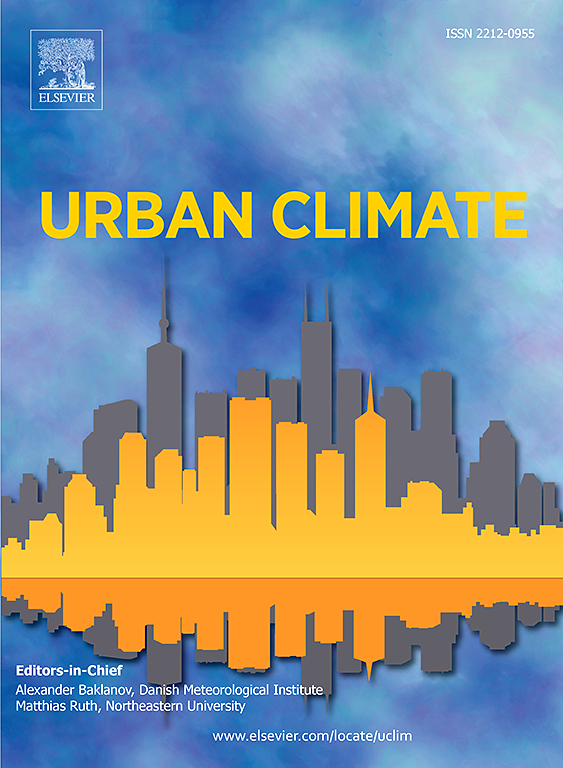2019 - 2020年冬季印度大城市居民区细颗粒物吸光特性研究
IF 6
2区 工程技术
Q1 ENVIRONMENTAL SCIENCES
引用次数: 0
摘要
在印度等低收入和中等收入国家的城市住宅室外地点,细颗粒质量浓度及其碳质特征未得到充分检查。这项研究是在2019-2020年冬季期间在印度三个大城市——孟买、班加罗尔和德里进行的。我们测量了每个城市住宅外的PM2.5,并描述了气溶胶的光学和化学性质。PM2.5质量浓度孟买为131.3±71.8 μg/m3,班加罗尔为75.2±33.4 μg/m3,德里为192.2±75.5 μg/m3,城市间差异显著,而城市内差异不显著(p <;0.05)。碳质成分也有类似的趋势。气溶胶吸收(babs)与单质碳(EC)在880 nm处呈中等正相关(0.19 ~ 0.45),表明单质碳是PM2.5吸收的主要成分。利用三个城市的城市特异性质量吸收截面(MAC范围为8.8-12.0),估计孟买的BC浓度为14.3±8.4,班加罗尔为8.7±5.6,德里为17.0±10.5 μg/m3。babs与水溶性有机碳(WSOC)具有较高的一致性(>0.70),表明棕色碳(BrC)的吸收优势。研究地点的平均埃吸收指数(AAE)为1.3,表明车辆排放的颗粒对光吸收能力的影响。babs比值为370/babs,880(1.1 ~ 4.7)表明BrC对光吸收系数有显著贡献。OC/EC(1.1 ~ 11.0)和OC/K+比值(1.0 ~ 51.0)表明不同来源的影响存在差异。因此,了解城市居住大气中气溶胶的性质使我们能够评估特定源排放的影响,并保证更广泛的控制和消除措施。本文章由计算机程序翻译,如有差异,请以英文原文为准。
Examining light absorbing characteristics of fine particulate matter during winter 2019–20 in residential areas of metropolitan cities in India
Fine particle mass concentrations and its carbonaceous characteristics are not adequately examined in urban residential outdoor locations in low and middle-income countries such as India. This study was conducted across three Indian metropolitan cities - Mumbai, Bangalore, and Delhi, during the winter period of 2019–2020. We measured PM2.5, outside residences in each city and characterized the optical and chemical properties of the aerosols. PM2.5 mass concentrations were 131.3 ± 71.8 for Mumbai, 75.2 ± 33.4 for Bangalore, and 192.2 ± 75.5 μg/m3 for Delhi, showing significant differences between cities and not within cities (p < 0.05). This trend was similar for carbonaceous constituents as well. Aerosol absorption (babs) and elemental carbon (EC) showed a moderate positive correlation (0.19–0.45) at 880 nm, which implies EC is the dominant component of absorption in PM2.5. Using the city-specific mass absorption cross-section (MAC ranging 8.8–12.0) for three cities, BC concentrations estimated were 14.3 ± 8.4 for Mumbai, 8.7 ± 5.6 in Bangalore and 17.0 ± 10.5 μg/m3 in Delhi. High agreement (>0.70) between babs and water-soluble organic carbon (WSOC) showed dominant absorption by brown carbon (BrC). Average angstrom absorption exponent (AAE) ∼1.3 across the study sites showed the influence of vehicle-emitted particles on light absorbing capacity. Ratio of babs,370/babs,880 (1.1 to 4.7) indicated a significant contribution of BrC to light absorption coefficient. OC/EC (1.1–11.0) and OC/K+ ratio (1.0–51.0) suggested the differential impact from various sources. Hence understanding the nature of aerosols in urban residential atmospheres allows us to assess the impact of source-specific emissions and warrants wider control and elimination measures.
求助全文
通过发布文献求助,成功后即可免费获取论文全文。
去求助
来源期刊

Urban Climate
Social Sciences-Urban Studies
CiteScore
9.70
自引率
9.40%
发文量
286
期刊介绍:
Urban Climate serves the scientific and decision making communities with the publication of research on theory, science and applications relevant to understanding urban climatic conditions and change in relation to their geography and to demographic, socioeconomic, institutional, technological and environmental dynamics and global change. Targeted towards both disciplinary and interdisciplinary audiences, this journal publishes original research papers, comprehensive review articles, book reviews, and short communications on topics including, but not limited to, the following:
Urban meteorology and climate[...]
Urban environmental pollution[...]
Adaptation to global change[...]
Urban economic and social issues[...]
Research Approaches[...]
 求助内容:
求助内容: 应助结果提醒方式:
应助结果提醒方式:


